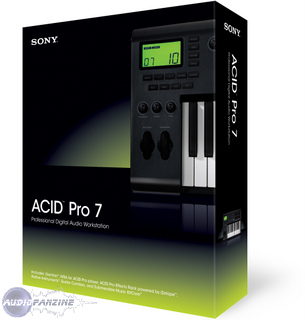

The software became very popular in the late 1990s and early 2000s among composers, producers, and DJs interested in quickly creating beats, music textures, or complete compositions and orchestrations, that would work with virtually any tempo or key signature. It was a loop-based music sequencer, in which Acid Loop files could be simply drag-and-dropped then automatically adjust to the tempo and key of a song with virtually no sonic degradation.Ī website for budding musicians using Acid technology was set up, named. Taken as an update, Acid Pro 7 is very good, but Sony still has work to do if Acid is to catch up with the current crop of do-it-all DAWs.Acid was first launched in 1998, as Acid pH1, by Sonic Foundry in Madison, Wisconsin. What's more, Acid is a convenient tool for multimedia audio production, and users of Sony's Vegas video editing software will feel at home right away.

Still, Acid's straightforward presentation and clear, easy interface are sure to be highly attractive to those who are put off by Live's plethora of advanced features.
#Sony acid pro 7 update upgrade
If you're already an Acid-addicted producer, this one is definitely worth the upgrade fee, but if you're looking for a loop-savvy DAW, then Ableton Live 7, which is arguably a more accomplished piece of software, can be picked up for around the same price. However, it does contain the interactive tutorials, and if you go for the boxed version, you get the same library of over 3000 high-quality samples that Pro users get. The software is great for beginners, although they'd be advised to plump for the much cheaper Acid Music Studio 7 (£38), which has the basic functionality of Pro but misses out on the majority of the new version 7 features. These enhancements are all very useful, but whereas Acid was once a genuinely innovative product, it seems that Sony is now playing catch-up with other developers, rather than breaking new ground. New users might wonder why there's no Paint Clip Selector displayed on their selected track, and there are no visual clues to suggest that zooming in or increasing the size of the track will make it appear.ĭespite these small niggles, though, the tutorials work well and do a great job of making the software inviting for new users. These are a great touch for anyone who isn't au fait with the software, and use overlaid graphics to make their points as plainly as possible. VideoĪn addition aimed more at Acid newbies, rather than experienced users, is the suite of interactive tutorials. However, it has to be said that Ableton's software is still a much more efficient solution when you're working with non-sequenced material. Tempo changes within a project are now possible, and the software has also gained support for the FLAC, AAC, AC-3 Studio, and MPEG-2 formats, thus making it a more credible multimedia production platform.Īlso, Acid's beatmapping now allows for tempo variation in audio, which isn't before time when you consider the flexible warping abilities that Live has had for years now. These enable the user to record external devices with effects, mix a variety of audio sources within the project and perform real-time input monitoring - all of which helps to make Acid feel more like a thoroughbred DAW. These include the addition of multiprocessor support, MIDI track freeze, a new plug-in bundle and the introduction of zplane's élastique Pro timestretching algorithm, which complements Acid's original timestretching mode.Ībleton Live uses élastique efficient, a less sophisticated (though more CPU-friendly) version, so this is one area where some may feel that Acid Pro has one over on its rival.įor those intending to use Acid's multitrack recording abilities, the addition of input busses and real-time rendering will surely appeal. While we've first dealt with the most obvious improvements, there are others that further help Acid hold its own as a serious piece of music production software. Most notably, the zoom function that enables you to change the size of all tracks simultaneously with a single slider works a treat and is something that we can imagine cropping up in other DAWs. Overall, the new mixer makes balancing, routing and carrying out other fundamental tasks that much easier, so we'd say that it's a success.

Quite how Sony managed to get away without having a proper mixer in its software for so long is anyone's guess, but we're sure that Acid Pro users will be overjoyed to finally have such an elementary feature added to their DAW.


 0 kommentar(er)
0 kommentar(er)
